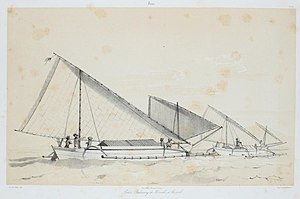


Paduwang (also known as bedouang) is a traditional double-outrigger vessel from Madura, Indonesia. It is built with planks instead of single log, and used for fishing, trading and transport of people and goods near Madura island.[1] In the 19th century, Paduwang was a popular fishing craft in East Java.[2]: 80
According to Horridge, the word “paduwang” have its roots from word wa, wangka, waga, wangga, and bangka of Austronesian languages. The term is associated with outrigger perahu or small perahu.[3] The name bedouang is used by western observer such as admiral François-Edmond Pâris, possibly a mispronunciation of the name.[2]: 80–81
Paduwang had two short masts, one is on the bow and the other is about 1/3 of the length behind. The rigging is using lete rig, which has upper yard (called pebahu) and lower yard (pekaki). Pebahu is always supported by bamboo support pole (called sokongorsupak).[4] The foresail is mounted on a short mast, while the mainsail has no mast. The mainsail is kept in position by vangs and other ropes attached to its yard.[5]

It has 2 versions, one with conventional ends, the other has bifid ends[6] (meaning bifurcated shape at the bow and stern-forming a "jaw").[7] The hull is built on a dugout keel, both ends closed by simple vertical board.[5] Paduwang only had 1 rudder, held by a rope, moored to a board. The rudder is always positioned under the direction of the wind, with such configuration that it can be switched to other side easily. Small paduwang is only 5 m in length, while large transport paduwang had a small deckhouse at the middle of the hull, and is about 14–16 m long. Paduwang can also be propelled using paddles.[2]: 81 Large paduwang disappeared in the early 20th century, not long after the emergence of golekan.[6]
Other fishing craft of Indonesia:
|
Indonesian traditional vessels and sails
| |||||||||||||||
|---|---|---|---|---|---|---|---|---|---|---|---|---|---|---|---|
| Type of sails and rigging |
| ||||||||||||||
| Naval & merchant vessels (by origin date) |
| ||||||||||||||
| Fishing vessels |
| ||||||||||||||